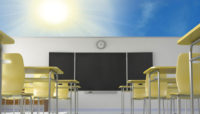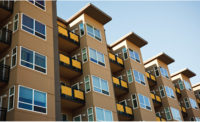Since the approach was somewhat new in the U.S., designers for two residence halls at Pacific University wanted to err on the conservative side regarding their variable refrigerant flow system’s projected savings. As it turns out, they needn’t have worried. Both projects picked up LEED Gold and exceeded Architecture 2030 Challenge targets while creating comfort flexibility for students.
Recognized by U.S. News and World Report as one of America’s Best Colleges 2008, Pacific University (Pacific) is a private liberal arts organization with professional programs in education and five health professions. The main campus is located 24 miles west of Portland, OR, on 55 acres in downtown Forest Grove, OR. The university enrolls 1,500 undergraduate students and 1,700 graduate students from 30 states and 28 foreign countries. The school was founded in 1849 by Congregational pioneers as the Tualatin Academy and became Pacific University in 1854.
PACIFIC UNIVERSITY: COMMITMENT TO GREEN BUILDING
Considered one of the greenest universities on the west coast, Pacific has had a long-time commitment to a green campus master plan shaped by the Association for the Advancement of Sustainability in Higher Education (AASHE) - a national association of colleges and universities working to create a sustainable future and to empower higher education to lead the sustainability transformation.
Pacific was early to embrace the Talloires Declaration - a towering statement for sustainability, created for and by presidents of institutions of higher learning. In 1990, Jean Mayer, Tufts University president, convened a conference of 22 universities in Talloires, France. This document is a declaration that institutions of higher learning will be world leaders in developing, creating, supporting, and maintaining sustainability. As of January, 2010, 413 college and university presidents from 52 countries have signed on (161 in the U.S.).
By the fall of 2003, Pacific already had a green strategic plan developed by the Students for Environmental Awareness (SEA). By the fall of 2005, there was a “Sustainability Food Movement,” a bachelor of arts degree in Environmental Studies, and a farm for studying permaculture. That year, the new library opened with a LEED certification. A year later, the city of Forest Grove ratified its own “Sustainable Master Plan” and the newest student housing facility, Burlingham Hall, opened with LEED Gold certification. In the fall of 2007, the next LEED Gold certification was given to Berglund Hall, home to the College of Education. Twelve months later, the next LEED Gold residence hall, Gilbert Hall, opened.
BURLINGHAM HALL: VRF PIONEER
Already experienced with the LEED design, construction, and certification process with other buildings on campus, in 2005 Pacific hired the Portland, OR, firms of Mahlum Architects and Interface Engineers to design a new environmentally sensitive residence hall.
The 59,000-sq-ft, 49-unit, fully wireless building would house 161 sophomores, juniors, and seniors in two-bedroom suites and four- to six-person, four-bedroom apartments. A typical apartment would have two bedrooms and a bathroom on either side of a living room and kitchen. The building would, for the first time, incorporate cooling in order to accommodate camps and programs during the hot summer months. The challenge would be to find a system that would provide heating as well as cooling that could be installed within budget and meet the overall sustainability and energy efficiency goals of the project and university. Design began in 2005 and a variable refrigerant flow (VRF) zoning system was considered as a potential candidate for the project.
In 2005, the widespread application and knowledge of VRF systems in the U.S. was in its infancy. Although used throughout the world for many years, it was only in 2003 that VRF systems had formally been introduced to the U.S. market. Taking a chance on a relative newcomer to the U.S. commercial HVAC landscape took careful deliberation by all parties of the design team.
After analyzing a number of systems for the Burlingham project, Interface recommended a Mitsubishi Electric VRF zoning system to be the basis of design. This was due to several key factors including the building’s orientation and the ability of the system to take maximum advantage of building diversity with energy sharing/recovery between zones. This allowed the outdoor units to be sized for block loads, electrical cost savings due to fewer condensing units on the roof than individual split systems, and the potential for higher efficiency equipment without the need for supplemental electric heat.
American Heating, Inc. (AHI) of Portland, was the contractor selected for the mechanical installation because, even at that time, the AHI team was already becoming expert in the application and installation of VRF technology. As first adopters of VRF system installation, AHI was instrumental in estimating the cost of installing VRF systems and relaying firsthand knowledge of the system to Pacific and the design team, making the decision to use this new system easier.
DEVELOPMENT OF A VRF ZONING ENERGY MODELING PROGRAM
A particular challenge in 2005 was analyzing VRF zoning systems compared to others from an energy efficiency standpoint. At the time, no mainstream energy modeling programs could model the system explicitly; workarounds were needed to be developed by Interface to realistically compare the energy use of a VRF system to traditional HVAC systems that had been modeled accurately for decades.
Adding to the complication, there were no formal testing procedures for VRF equipment, so obtaining a true picture for the energy efficiency of the system took engineering reasoning and a little faith in the technology. Working closely with Mitsubishi engineers to develop a true energy model, Interface took a conservative approach, scaling back the original estimated energy savings by nearly 15%.
In addition to a high-performance VRF zoning system, Burlingham Hall also features a heat recovery system for outside air composed of a heat recovery wheel and a side stream condensing furnace to further pre-heat outside air upstream of the fancoils. Additional sustainable features include: high-performance windows, high-efficiency lighting systems, stormwater bioswales, and low-flow kitchen and bath fixtures.
Because of the high-performance VFD heat pump technology and the relatively mild temperatures in the Pacific Northwest, Interface found that no additional heat source (backup electric heat) was required for each suite. This means that Burlingham takes advantage of heat pump efficiency throughout the heating season, eliminating the buildings’ peak electric draw on the power grid. The system also provided advantages from a structural and architectural standpoint. The small footprint and light weight of the outdoor units enabled them to be placed in a convenient, centrally located area on the roof.
VRF ENERGY EFFICIENCY PERFORMANCE DOCUMENTATION: REAL WORLD DATA
Burlingham Hall became the first LEED Gold VRF project in the United States. After the first 12 months of operation, Interface had the ability to go back and compare their original computed energy model data to real world data. The comparison found that total gas usage was 67% less than their baseline energy model. It used 17% fewer therms than they anticipated (modeled) for the building. The electricity (kWh) used was 28.9% less than was projected for the building to consume.
With these energy savings numbers, Interface discovered that they could have achieved at least two additional LEED credits for Burlingham if they had proceeded with their original model. The ability to now definitively document energy efficiency performance of a VRF zoning system in the real world would allow the pioneering Burlingham design team, as well as peers throughout the country, to better predict energy usage of VRF systems. The first year’s energy performance has tracked almost identically over the last three years.
GILBERT HALL: SECOND APPLICATION OF VRF ZONING SYSTEMS
Named for the celebrated Pacific University student A.C. Gilbert - creator of two American icons, the American Flyer electric train and the erector set - Gilbert Hall would be the newest residence hall located on the North side of the campus. Opening in the fall of 2008, the 61,520-sq-ft facility would have four floors, eight six-person apartments (48 beds), 13 four-person apartments (52 beds), 11 four-person suites (44 beds) and four three-person suites (12 beds), student housing for 157 students.
In the spring of 2006, PAE Consulting Engineers of Portland was hired by Mahlum Architects,, the architect responsible for designing Burlingham Hall. The comprehensive goals of the PAE-Mahlum design team would be initially to achieve LEED Gold certification, and ultimately to attain an EPA ENERGY STAR rating for Gilbert Hall. The newest residence hall would also be designed with the new Architecture 2030 Challenge in mind. (See 2030 Challenge Sidebar.)
Determined to achieve LEED Gold, as well as the aggressive goals of the 2030 challenge, PAE embarked on an integrated design process analyzing all aspects of the building design, including assessing the existing Burlingham utility costs and operating characteristics, evaluating the local climate and using the climate analysis to help shape the building orientation, developing a detailed energy model to evaluate where the energy is used and explore ways to save energy (cooling, heating, lighting, plug loads), studying envelope energy losses (windows, walls, doors, infiltration), comparing high-performance HVAC systems (radiant floor heating, water source heat pump, VRF zoning), and setting up the building with the ability to integrate future on-site renewable energy systems (photovoltaics and solar hot water).
VRF SELECTED OVER FOUR OTHER OPTIONS
For Gilbert Hall, PAE researched the advantages and disadvantages of five different HVAC systems: finned-tube radiators, radiant floor heating and cooling, water source heat pumps, Mitsubishi Electric VRF zoning and ground source heat pumps.
Due to the research and findings, PAE eventually selected the VRF zoning system. The system had low energy costs, provided the cooling needed for university summer programs, was cost competitive within the project budget, and had the backing of the university based on the previous successful project. American Heating returned for the Gilbert Hall VRF installation providing their VRF installation expertise.
Student housing is known for its low floor heights, so the design team appreciated the low-profile ducted units for the student apartments. One of the reasons they selected VRF is because there was no need for boilers, chillers, or additional mechanical rooms which take up usable floor space and add project costs.
The design team also incorporated into the Gilbert Hall design a dedicated outside air system (DOAS) with heat recovery. The cooling and heating of ventilation air load can be a major energy consumer. By providing the exact ventilation airflow required, the ventilation load can be significantly decreased. In addition, by utilizing air-to-air energy recovery, the ventilation load component seen by the VRF zoning system is greatly reduced, allowing higher performance operation at low ambient outside air temperatures.
MEETING ENERGY EFFICIENCY GOALS
The average energy use index (EUI) for student housing projects in the Northwest U.S. is 80 kBtuh/sq ft/yr. EUI is a standard measure of a building’s energy usage comparing energy used per square foot per year to similar buildings in similar climates. By continuing to monitor actual performance, Interface documented that Burlingham Hall achieved an EUI of 45 kBtuh/sq ft/yr based on actual energy bills. Gilbert Hall also had excellent energy efficiency performance with an EUI of 46 kBtuh/sq ft/yr based on actual energy bills. Both consume roughly 44% less energy than the average student housing building in the NW.
The 2030 Challenge was in its early stages when Gilbert Hall was designed. However, the Challenge’s 10%-a-year incremental rate goal was to achieve 50% reduction for buildings built before 2010. Judging by this benchmark, the design team’s planning for Gilbert Hall achieved high marks for Architecture 2030. Gilbert Hall meets the 2010 threshold that it was designed under. By having an EUI of 30 kBtuh/sq ft/yr of non-renewable energy usage after purchasing 20% green power, Gilbert actually exceeds the current threshold and meets the 2015 mark by achieving a 60% reduction over the average EUI of 80 kBtuh/sq ft/yr. The projects did achieve the overall operational savings they had forecast and they both achieved LEED Gold certification.
EASE OF INSTALLATION AT BURLINGHAM AND GILBERT HALLS
HVAC contractor American Heating, Inc. (AHI) is a Mitsubishi Electric VRF Diamond Designer. AHI Project Manager Brian Shea was involved with every LEED installation on the Pacific Campus. He admires the Mitsubishi VRF zoning equipment and technology. “It’s a great option for today’s buildings where there are more and more tight spaces,” Shea said. “Because it’s a two-pipe system, Mitsubishi’s VRF is a very clean way to move energy efficiently through tight spaces.” Shea also points out that chillers most often require cranes for installation, but VRF zoning systems and outdoor units have a small footprint, are lightweight, modular and frequently eliminate the need for costly mechanical rooms. VRF outdoor units can often be brought to the roof on a service elevator.
VRF ZONING SYSTEM APPLICATION: 2010 AND BEYOND
With valuable lessons learned from Burlingham and Gilbert Halls, both Interface and PAE are now busy designing student housing and other projects for other universities with the same aggressive energy goals, utilizing a variety of creative project specific systems and approaches. With the 2030 fossil fuel reduction standard for all new buildings set for 70% in 2015, the firms are focusing on implementing innovative, sustainable design strategies, such as using geothermal water source units, triple-pane windows, and generating on-site renewable power. With the success of both of these buildings, VRF zoning systems have proven to be a relevant added tool in the engineer’s toolbox to achieve the aggressive energy efficiency goals of the future.
With the emergence of VRF water source units over the last couple of years, the opportunity for continued innovative and creative application of VRF technology is continuing to become a reality. The ability to couple water source VRF units with ground source loops offer the ability to recover heat not only through the refrigerant circuit, but also through the entire condenser water loop, taking advantage of the earth’s ability to provide a low cost heat source and heat sink due to the stable energy capacity of the ground.
Additionally, it is also possible to make use of heat pump boiler equipment that is able to generate domestic hot water utilizing the VRF zoning system. This offers the opportunity to couple domestic hot water loads as well as radiant floor and heating water coil heating for DOAS systems into the overall VRF system design.
PACIFIC STANDARD TIME
Chuck Carpenter is the veteran facilities engineer for HVACR at Pacific. He has a busy schedule keeping a watchful eye over the 48 HVACR systems under his care.
It is his goal to make the VRF system the HVAC standard for all new student housing projects on the Pacific campus. He speaks highly of the quietness of the system and admires the VRF zoning that allows one student apartment to be 72°F next door to a suite set at a different temperature, ensuring individual comfort throughout the year.
“Gilbert Hall is performing wonderfully,” Carpenter says. He speaks highly of the PAE-Mahlum team contributions at Gilbert Hall. He said that Pacific will also be installing a Mitsubishi split zoning system for IT rooms at the new medical center building at the Hillsboro campus - destined to become Pacific’s fifth LEED Gold certified building.
The Architecture 2030 Challenge
The “Architecture 2030 Challenge” sets a goal for all buildings to be carbon neutral by 2030. It has an incremental approach to achieving that goal to reduce carbon emissions for new buildings and renovations compared to a typical regional building. The baseline is by the 2030 Commercial Building Energy Consumption Survey (CBECS), which is a national sample survey that collects information on the stock of U.S. commercial buildings, their energy-related building characteristics and their energy consumption and expenditures.
The goal for buildings constructed prior to 2010 was to achieve a minimum 50 percent reduction from the current level of consumption of fossil fuels used to construct and operate new and renovated buildings.
The incremental goals promote further reductions of remaining fossil-fuel consumption by 10% or more in each of the following five years until all buildings are carbon neutral by 2030. The 2030 Challenge also puts a cap of 20% for purchasing green power or using renewable energy credits (RECs) to achieve the carbon reduction goals. This is to encourage designers to reduce the fossil fuel use and not “buy their way” to carbon neutrality.
As opposed to the LEED rating system for sustainable buildings, which looks at not only energy efficiency in buildings, but also many aspects of green buildings such as recycled materials, proximity of the building to public transportation and water usage reduction, the 2030 Challenge deals specifically with energy efficiency and renewable power.




